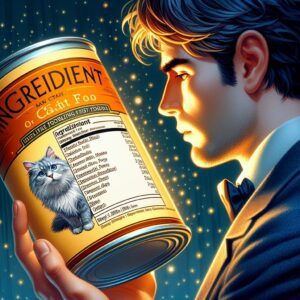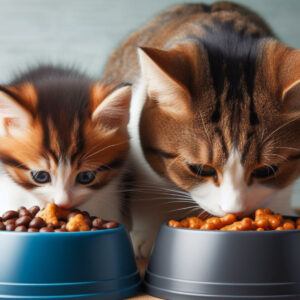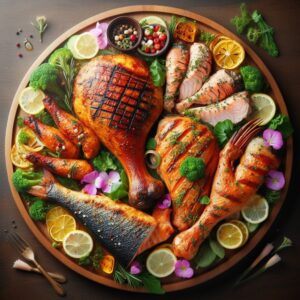Navigating Cat Food Labels: What You Need to Know
 Let’s examine why reading cat food labels closely is more than just skimming the contents. It’s essential to preserving your feline friend’s lifespan and health. This means breaking down the key components frequently present on labels and learning about the rules and guidelines governing pet food labeling.
Let’s examine why reading cat food labels closely is more than just skimming the contents. It’s essential to preserving your feline friend’s lifespan and health. This means breaking down the key components frequently present on labels and learning about the rules and guidelines governing pet food labeling.
Why is this relevant? Cats need a balanced diet specific to their age, size, and overall health, just like humans do. And how would you find this balance once you’ve mastered deciphering the label’s explanations and numerical numbers?
You wouldn’t want to inadvertently cause your pet pain or health issues due to nonspecific or missing labels. Can you accept claims from a brand that it is “natural” or “premium” without question? That’s precisely what we’ll explore.
I promise you that learning to read a cat food label is an invaluable skill that will help you and your cat tremendously. Furthermore, what do you know? After you’ve mastered the principles of label inspection, you can examine the ingredient list and determine exactly what your cat is eating. Our next frontier to be conquered is that.
Deciphering Ingredients:
What’s Really Inside Your Cat’s Food
Examining a cat food label closely reveals the real story in the ingredient list. Ingredients are sorted by weight and placed in descending order, just like food labels for humans. As such, the first elements are the most important, so it’s essential to have premium proteins leading the way. Now, let’s explore what that means.
 Proficient proteins should be easily recognized and accurate. Words like “turkey,” “salmon,” or “chicken” denote excellent sources of protein. On the other hand, be cautious when using vague terms such as “meat by-products” or “poultry by-products,” as they usually refer to less appetizing animal parts that are subject to change from batch to batch.
Proficient proteins should be easily recognized and accurate. Words like “turkey,” “salmon,” or “chicken” denote excellent sources of protein. On the other hand, be cautious when using vague terms such as “meat by-products” or “poultry by-products,” as they usually refer to less appetizing animal parts that are subject to change from batch to batch.- Yes, protein isn’t the only factor to take into account. Additionally, you may come across ingredients that aren’t the best for your kitty. Some producers use fillers like wheat and corn, which have minimal nutritional value. There may also be artificial flavors, colors, and preservatives. Certain substances, such as mixed tocopherols, a type of vitamin E, are safe, but other substances can cause debate.
- Be cautious if you encounter preservatives such as “butylated hydroxyanisole” (BHA) or “butylated hydroxytoluene” (BHT), as there is disagreement on their safety. Furthermore, cats don’t need coloring; they don’t choose their kibble based on appearance. Choosing a brand that avoids these ingredients guarantees your cat’s health won’t be harmed.
Choosing a cat food with a transparent, healthy ingredient list lays a strong foundation for your cat’s health. But it’s important to understand that the ingredient list is just the beginning. We’ll then discuss whether the food meets your cat’s dietary requirements.
Nutritional Adequacy and Feeding Guidelines:
Ensuring Your Cat’s Dietary Needs Are Met
Choosing the correct cat food is more than just deciding; it also entails selecting a product that aligns with your cat’s specific dietary needs. It’s essential to read the nutritional adequacy statement on cat food packaging. This part of the label provides information on whether the food provides a complete and balanced diet appropriate for your cat’s life stage.
The Association of American Feed Control Officials (AAFCO) has set guidelines that cat food manufacturers must meet to claim that their product is ‘complete and balanced.’ Look for phrases like ‘formulated to meet the nutritional levels established by the AAFCO Cat Food Nutrient Profiles.’ If you see this, the food should cover all the bases for a healthy feline diet.
 Another important consideration is the need for eating guidelines, which are often ignored. Considering your cat’s weight and activity level, these recommendations will help you determine how much cat food is right for them. Underfeeding can lead to dietary shortages, while overfeeding can increase obesity—a widespread problem in indoor cats.
Another important consideration is the need for eating guidelines, which are often ignored. Considering your cat’s weight and activity level, these recommendations will help you determine how much cat food is right for them. Underfeeding can lead to dietary shortages, while overfeeding can increase obesity—a widespread problem in indoor cats.
Ensuring kittens and elderly cats eat the right food is essential. While older cats may need fewer calories but more nutrients to meet age-related needs, kittens need a larger intake of calories and nutrients to sustain their rapid growth. Furthermore, a specific diet may be required if your cat is overweight or has medical issues. Getting advice from your veterinarian is essential when choosing the best diet for your cat’s requirements.
Beyond the Label: Tips for Choosing the Best Cat Food
There’s more to choosing the best cat food for your furry buddy than just reading labels. Although this is undoubtedly a practical first step, it’s also critical to consider several other criteria to make an informed decision. I’m here to help you see the bigger picture.
- Reading pet owners’ online evaluations can provide insightful information but proceed cautiously when reading them. Examine reviewers’ comments for consistency and pay close attention to any mentions of product recalls. Recall trends might act as red flags, alerting you to possible problems you should avoid.
 Be careful not to get too hung up on the price tag—it may not always be accurate. Instead, try to strike a balance between cost and nutrient content. Sometimes, less expensive products might provide nutrition that is on par with or even better than luxury brands. Finding value for your money is crucial.
Be careful not to get too hung up on the price tag—it may not always be accurate. Instead, try to strike a balance between cost and nutrient content. Sometimes, less expensive products might provide nutrition that is on par with or even better than luxury brands. Finding value for your money is crucial.- There will undoubtedly be discussion on the pros and cons of wet versus dry cat food. Every variety offers benefits, and your choice may depend on your feline friend’s inclinations or particular veterinary advice. In the end, choose something that suits your tastes as well as the requirements of your cat.
- Finally, you may modify your strategy for precious furballs with particular demands, like weight control, allergies, or chronic diseases. Understand that there is no one-size-fits-all solution for nutritional requirements, so don’t be afraid to ask your veterinarian for specific advice. They can provide customized guidance to ensure your cat’s food satisfies its unique needs.
Refrain from obsessing over attaining perfection. Your cat’s food requirements are ever-changing, so adaptability is essential. My genuine goal is that this information will enable you to confidently select the best cat food for your pet. Remember that you deserve praise for your commitment to self-education.
We appreciate you putting your cat’s well-being and health first. And don’t be afraid to get in touch with me if you need any extra support or direction—I’m always available to help. You may leave a comment in the “Leave a Comment” area below. Thank you.
-Janice-

 Proficient proteins should be easily recognized and accurate. Words like “turkey,” “salmon,” or “chicken” denote excellent sources of protein. On the other hand, be cautious when using vague terms such as “meat by-products” or “poultry by-products,” as they usually refer to less appetizing animal parts that are subject to change from batch to batch.
Proficient proteins should be easily recognized and accurate. Words like “turkey,” “salmon,” or “chicken” denote excellent sources of protein. On the other hand, be cautious when using vague terms such as “meat by-products” or “poultry by-products,” as they usually refer to less appetizing animal parts that are subject to change from batch to batch. Be careful not to get too hung up on the price tag—it may not always be accurate. Instead, try to strike a balance between cost and nutrient content. Sometimes, less expensive products might provide nutrition that is on par with or even better than luxury brands. Finding value for your money is crucial.
Be careful not to get too hung up on the price tag—it may not always be accurate. Instead, try to strike a balance between cost and nutrient content. Sometimes, less expensive products might provide nutrition that is on par with or even better than luxury brands. Finding value for your money is crucial.